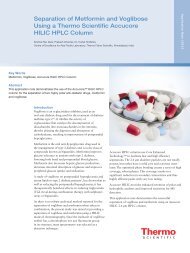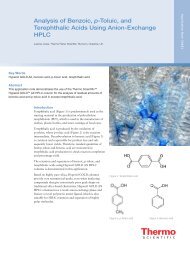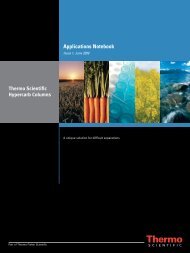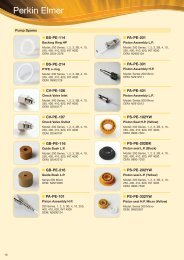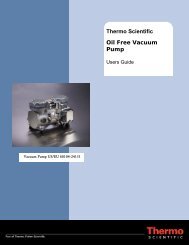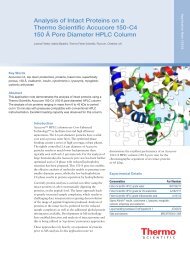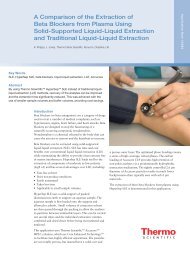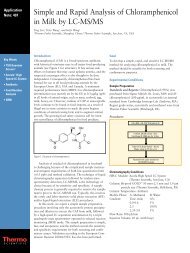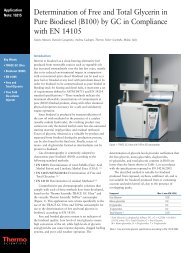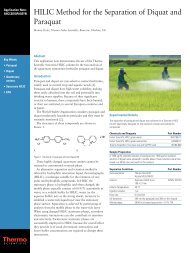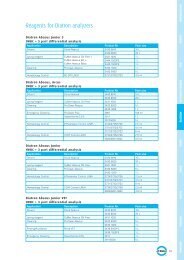Chemical Reference Standards AccuStandard®
Chemical Reference Standards AccuStandard®
Chemical Reference Standards AccuStandard®
You also want an ePaper? Increase the reach of your titles
YUMPU automatically turns print PDFs into web optimized ePapers that Google loves.
Explosives<br />
The ability to detect the presence of explosives from a distance of a few millimeters to several meters serves several different purposes, such as:<br />
Training dogs and other animals to detect bombs & landmines<br />
Automated Explosive Detection Systems at airports to electronically “sniff” baggage and people to detect bombs<br />
Analysis to aid the remediation of contaminated soil and water at ordnance sites<br />
Individual Explosives<br />
AccuStandard synthesizes the important explosives and their metabolites, raw materials & degradates and makes them available in usable forms to:<br />
Government Agencies such as The Transportation Security Administration (TSA) formerly the FAA, has the responsibility for safety of air travel<br />
and embassies, a concern shared by all nations. The FBI uses the reference standards to confirm the presence of particular compounds when<br />
screening objects and people.<br />
Instrument Manufacturers’ instruments that are used in airports and embassies require documented reference materials to maintain their<br />
performance in generating reliable data.<br />
Research Facilities where there is a need for constant development of procedures and reference standards to combat new terrorist threats.<br />
Monitoring Labs for remediation of contaminated soil and water from the storage and use of explosives at ordnance sites has been ongoing for<br />
the last thirty years. The US EPA developed its own method, Method 8330, to define the procedure that is used globally.<br />
AccuStandard is a leading company in the Explosive <strong>Standards</strong> area offering about sixty explosives, degradates and metabolites (most synthesized<br />
in-house) in addition to the many special formulations for customer-specific applications and EPA method-specific formulations. AccuStandard is the<br />
only commercial source for TATP, HNS, and HMTD due to the excellent work of its Synthesis Department. If there is an explosive standard that you<br />
require that is not listed, please contact AccuStandard's Technical Service Department for a quotation.<br />
Explosive <strong>Standards</strong> are listed as follows:<br />
Single Solutions<br />
International Methods<br />
USEPA Mixtures<br />
Explosive <strong>Standards</strong><br />
Explosives (in 1 mL of solvent, unless otherwise noted)<br />
COMPOUND CAS NO. QTY./CONC. MATRIX CAT. NO. UNIT PRICE<br />
2-Amino-4,6-dinitrotoluene 35572-78-2 0.1 mg/mL MeOH:AcCN (1:1) M-8330-13-0.1X 1 mL 20<br />
1 mg/mL MeOH:AcCN (1:1) M-8330-13 1 mL 20<br />
4-Amino-2,6-dinitrotoluene 19406-51-0 0.1 mg/mL MeOH:AcCN (1:1) M-8330-14-0.1X 1 mL 20<br />
1 mg/mL MeOH:AcCN (1:1) M-8330-14 1 mL 20<br />
Ammonium picrate 0.1 mg/mL AcCN M-8330-ADD-27 ‡ 1 mL 25<br />
1,2-Diaminopropane 78-90-0 0.1 mg/mL MeOH M-8330-ADD-9 1 mL 20<br />
1,2-Dinitrobenzene 528-29-0 1 mg/mL MeOH M-8330-SS 1 mL 20<br />
1,3-Dinitrobenzene 99-65-0 0.1 mg/mL MeOH:AcCN (1:1) M-8330-01-0.1X 1 mL 20<br />
1 mg/mL MeOH:AcCN (1:1) M-8330-01 1 mL 15<br />
2,3-Dimethyl-2,3-dinitrobutane 3964-18-9 100 µg/mL AcCN M-8330-ADD-21 1 mL 30<br />
2,4-Diamino-6-nitrotoluene 6629-29-4 0.1 mg/mL AcCN M-8330-ADD-12 1 mL 40<br />
2,4-Dinitrotoluene 121-14-2 0.1 mg/mL MeOH:AcCN (1:1) M-8330-02-0.1X 1 mL 20<br />
1 mg/mL MeOH:AcCN (1:1) M-8330-02 1 mL 15<br />
2,6-Diamino-4-nitrotoluene 59229-75-3 0.1 mg/mL AcCN M-8330-ADD-13 1 mL 40<br />
2,5-Dinitrotoluene 619-15-8 100 µg/mL AcCN M-8095-SS-03 1 mL 50<br />
2,6-Dinitrotoluene 606-20-2 0.1 mg/mL MeOH:AcCN (1:1) M-8330-03-0.1X 1 mL 20<br />
1 mg/mL MeOH:AcCN (1:1) M-8330-03 1 mL 15<br />
3,4-Dinitrotoluene 610-39-9 100 µg/mL AcCN M-8095-SS-01 1 mL 15<br />
1 mg/mL MeOH M-8330-IS 1 mL 15<br />
EGDN 628-96-6 0.1 mg/mL AcCN M-8330-ADD-5 1 mL 20<br />
Guanidine nitrate 506-93-7 0.1 mg/mL MeOH M-8330-ADD-10 1 mL 20<br />
Hexanitrostilbene (HNS) 0.1 mg/mL AcCN M-8330-ADD-26 1 mL 60<br />
HMX 2691-41-0 0.1 mg/mL MeOH:AcCN (1:1) M-8330-04-0.1X 1 mL 20<br />
1 mg/mL MeOH:AcCN (1:1) M-8330-04 1 mL 30<br />
HMTD 0.1 mg/mL AcCN M-8330-ADD-25 ‡ 1 mL 75<br />
2-Hydroxylamino-4,6-dinitrotoluene 0.1 mg/mL AcCN M-8330-ADD-18 ‡ 1 mL 115<br />
4-Hydroxylamino-2,6-dinitrotoluene 0.1 mg/mL AcCN M-8330-ADD-20 ‡ 1 mL 115<br />
Hydrazine 302-01-2 0.1 mg/mL MeOH M-8330-ADD-8 1 mL 20<br />
Nitrobenzene 98-95-3 0.1 mg/mL MeOH:AcCN (1:1) M-8330-06-0.1X 1 mL 20<br />
1 mg/mL MeOH:AcCN (1:1) M-8330-06 1 mL 15<br />
Nitroglycerin 55-63-0 0.1 mg/mL EtOH M-8330-ADD-1 1 mL 20<br />
Nitroguanidine 556-88-7 0.1 mg/mL MeOH M-8330-ADD-6 1 mL 20<br />
Nitromethane 75-52-5 0.1 mg/mL MeOH M-8330-ADD-7 1 mL 20<br />
2-Nitrotoluene 88-72-2 0.1 mg/mL MeOH:AcCN (1:1) M-8330-07-0.1X 1 mL 15<br />
1 mg/mL MeOH:AcCN (1:1) M-8330-07 1 mL 15<br />
3-Nitrotoluene 99-08-1 0.1 mg/mL MeOH:AcCN (1:1) M-8330-08-0.1X 1 mL 15<br />
1 mg/mL MeOH:AcCN (1:1) M-8330-08 1 mL 15<br />
4-Nitrotoluene 99-99-0 0.1 mg/mL MeOH:AcCN (1:1) M-8330-09-0.1X 1 mL 15<br />
1 mg/mL MeOH:AcCN (1:1) M-8330-09 1 mL 15<br />
PETN 78-11-5 0.1 mg/mL MeOH M-8330-ADD-2 1 mL 20<br />
Picramic acid 831-52-7 100 µg/mL AcCN:MeOH M-8330-ADD-22 1 mL 30<br />
Picric acid 88-89-1 0.1 mg/mL AcCN:MeOH M-8330-ADD-3 1 mL 20<br />
Propyleneglycol dinitrate 0.1 mg/mL MeOH M-8330-ADD-35 ‡ 1 mL 35<br />
PYX 38082-89-2 0.1 mg/mL AcCN M-8330-ADD-11 1 mL 20<br />
RDX 121-82-4 0.1 mg/mL MeOH:AcCN (1:1) M-8330-05-0.1X 1 mL 20<br />
1 mg/mL MeOH:AcCN (1:1) M-8330-05 1 mL 30<br />
TATP 0.1 mg/mL AcCN M-8330-ADD-24 ‡ 1 mL 75<br />
Tetryl 479-45-8 0.1 mg/mL MeOH:AcCN (1:1) M-8330-10-0.1X 1 mL 20<br />
1 mg/mL MeOH:AcCN (1:1) M-8330-10 1 mL 30<br />
2,2',6,6'-Tetranitro-4,4'-azoxytoluene 0.1 mg/mL AcCN M-8330-ADD-15 1 mL 75<br />
124<br />
‡ To delay premature breakdown of thermally labile products in transit we suggest shipping with a “Cold Pack”<br />
AccuStandard’s Quality System is Certified to comply with the International ISO 9001:2000 Quality Standard



